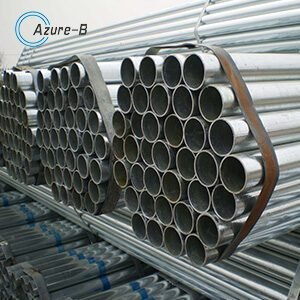Galvanized Steel Pipe
| Grade | SCr420TK, SCM415TK, SCM418TK, SCM420TK, SCM430TK, SCM435TK, SCM440TK |
|---|---|
| OD | 38 – 426mm |
| WT | 5 – 60mm |
| Length | 3000-12000mm |
| Application | used for machinery, automobiles, and other machine parts. |
| Equivalent standards | ASTM A519, EN 10297-1 |
Description
Galvanized steel pipes are divided into cold galvanized steel pipes and hot galvanized steel pipes. Cold galvanized steel pipes have been banned, and the latter has been temporarily promoted by the state for use. In the 1960s and 1970s, developed countries internationally began to develop new types of pipes and gradually banned galvanized pipes. The Chinese Ministry of Construction and other four ministries have also issued a decree prohibiting galvanized pipes as water supply pipes since 2000. Galvanized pipes are rarely used in cold water pipes in newly built residential areas, and some hot water pipes in residential areas use galvanized pipes. Hot dip galvanized steel pipes are widely used in fire protection, electricity, and highways.
Hot dip galvanized pipes are formed by reacting molten metal with an iron substrate to produce an alloy layer, thereby combining the substrate and coating. Hot dip galvanizing is the process of first pickling steel pipes to remove iron oxide from their surface. After pickling, the steel pipes are cleaned in an ammonium chloride or zinc chloride aqueous solution or a mixture of ammonium chloride and zinc chloride aqueous solution, and then sent to the hot dip galvanizing tank. Hot dip galvanizing has the advantages of uniform coating, strong adhesion, and long service life. The substrate of hot-dip galvanized steel pipes undergoes complex physical and chemical reactions with the molten plating solution, forming a corrosion-resistant and tightly structured zinc iron alloy layer. The alloy layer is integrated with the pure zinc layer and the steel pipe substrate, so its corrosion resistance is strong.

Cold galvanized pipes are galvanized by electricity, with a small amount of galvanizing, only 10-50g/m2, and their corrosion resistance is much different from that of hot-dip galvanized pipes. Most legitimate galvanized pipe manufacturers do not use electric galvanizing (cold plating) to ensure quality. Only small enterprises with outdated equipment and small scale use electrogalvanizing, and of course, their prices are relatively cheaper. The Ministry of Construction has officially announced the elimination of outdated cold galvanized pipes and the prohibition of using cold galvanized pipes as water and gas pipes. The galvanized layer of cold galvanized steel pipes is an electroplating layer, which is independently layered with the steel pipe substrate. The zinc layer is relatively thin and simply adheres to the steel pipe substrate, making it easy to fall off. Therefore, its corrosion resistance is poor. In newly built residential buildings, it is prohibited to use cold galvanized steel pipes as water supply pipes.


